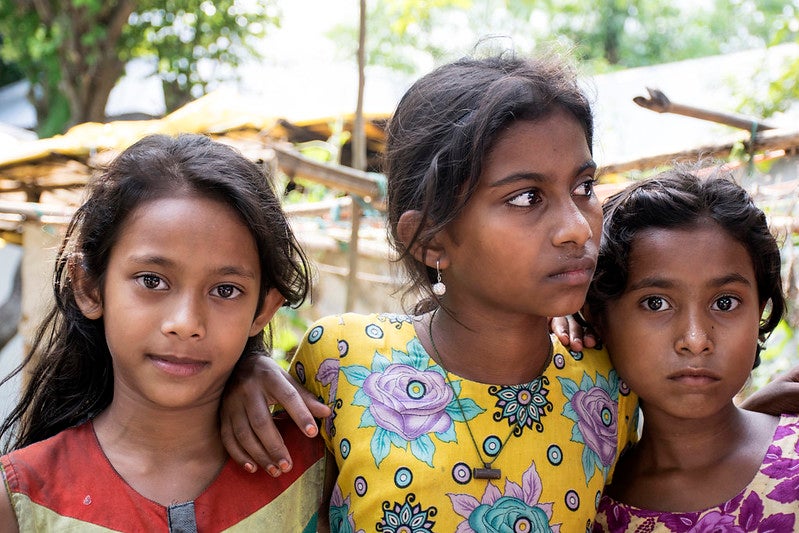 Women at the Gonoshasthaya Community Health Center (outside Dhaka). Photo: Rama George-Alleyne / World Bank
Women at the Gonoshasthaya Community Health Center (outside Dhaka). Photo: Rama George-Alleyne / World Bank
Seeing is believing. In May 2016, a delegation from 5 Sahelian countries - Burkina Faso, Chad, Mali, Mauritania, and Niger – traveled to Bangladesh to learn how the country was able to bring about a rapid demographic transition, with sustained support focused on reproductive and women’s’ health. The South-South knowledge exchange brought together Ministers and policy makers for an intensive one-week agenda, filled with discussion, multiple site visits, shared good humor, and complicated language interpretation (French/Bengali/English)!
The success story in Bangladesh is indeed remarkable. In the early 1970s, the total fertility rate or the average number of births per woman in Bangladesh was 6.9 births per woman. In 2020, that number has declined to 2.0 births per woman. This achievement is even more impressive given that it was largely achieved while the country was in the midst of tackling serious economic and social challenges.
Moreover, as the pace of fertility decline picked up, it contributed to a dramatic decrease in Bangladesh’s extreme poverty rate - from 43.8 percent in 1991 to 14.8 percent by 2016 , and a more than doubling of its per-capita GDP this past decade.
Evidence shows that declining total fertility rates can improve human capital, reduce poverty, and drive economic growth. Smaller families often mean that parents are able to invest more resources in the health and education of their children. This human capital accumulation, when combined with policies that generate good jobs for large numbers of the working age population, can drive economic growth and makes countries wealthier.
One major factor in Bangladesh’s success is attributed to the government’s prioritization of demographics in the national policy agenda, adopting a whole-of-government approach.

1. Embed demographic issues across Ministries and policy agendas
One major factor in Bangladesh’s success is attributed to the government’s prioritization and commitment to demographics in the national policy agenda, adopting a whole-of-government approach. The government prioritized demographics in the country’s first Five-Year Plan in 1971, recognizing that high fertility not only jeopardized the health of both the woman and her children but also represented a major constraint to the country’s economic development.
The widely respected National Planning Commission provided leadership, coordination, and oversight over the development of the Five-Year Plan. Numerous ministries including health, education and religious affairs, then integrated these issues into their planning, resulting in a multi-sectoral coalition.
2. Invest in research that translates into policy actions
Early on in its efforts, Bangladesh invested in rigorous research and evaluation, which was essential to enable evidence-based program design and implementation. Academic institutions, NGOs, development partners, and the government collaborated on the research and in scaling-up innovative solutions.
A key such effort was in 1977, when the International Centre for Diarrhoeal Disease Research, Bangladesh initiated an experimental Family Planning and Maternal and Child Health (FPMCH) program in the religiously conservative area of Matlab. Under the program, community health workers made regular home visits to married women in the villages and offered them a choice of family planning methods.
Evaluations showed that families living in the program intervention area became healthier and wealthier compared to those in a comparison area. Incorporating results of the research from Matlab into the design of Bangladesh’s national Family Planning Program was vital to improving its impact.
The use of evidence-based approaches went further. In the mid-1990s the Ministry of Education started the Female Secondary School Stipend Program, which provided free tuition and stipends universally to eligible girls from grade 6 to 10, conditional on school attendance, maintaining exam scores, and remaining unmarried until age 18 or completing secondary school. Evaluations showed the program resulted in a tripling of the number of girls enrolled in secondary school and a decline in early marriage.
By effectively and actively engaging with community and local influencers, Bangladesh was able to garner broader support.

3. Sustain policy commitments across administrations
Fertility changes at the level of the population requires individual behavior change and this requires time. The high-level leadership of the National Planning Commission over population policy continued over the decades with steady focus and priority on the issue – with changes largely limited to implementation framework rather than to the priority given to the issue. This has resulted in Five-Year Plans for close to 50 years to date maintaining a concerted national commitment to population issues and sustaining it across successive administrations, regardless of political party.
4. Mobilize “local influencers” including religious leaders…and Women
Through the Imam Academy under the Ministry of Religious Affairs, trainings have been delivered over the last few decades to thousands of community religious leaders on matters concerning women’s health including family planning and reproductive health. This empowered religious leaders to use religious texts to explain to their local communities that Islam does not prohibit family planning – helping to legitimize the program from a religious perspective.
The family planning program also relied heavily on a door-to-door, face-to-face, woman-to-woman approach to service delivery and communications through a massive deployment of married, salaried female outreach workers , who were recruited from the communities that they served.
By effectively and actively engaging with community and local influencers, Bangladesh was able to garner broader support for more rapid change in social norms, preferences, and behaviors.
Bangladesh’s success in its demographic transition is an outcome of a clear political will and policy direction, coupled with a commitment to an evidence-based and well-designed comprehensive strategy to empower and enable women and families to achieve their desired family size. Other countries that are struggling to achieve this transition and set the stage for the economic gains that can follow, can learn much from Bangladesh’s approach and success.
This blog is based on several sources, including a case study of the Bangladesh experience conducted by the World Bank’s Human Capital Project. Read the complete Bangladesh Case Study here (PDF)




Join the Conversation